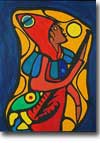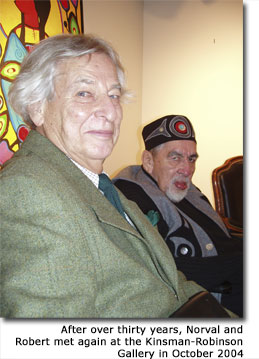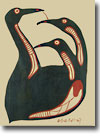![]()
![]()
 St. Michael |
|
|
 |
||
| Norval Morrisseau ~ 1932 - 2007 |
When I first met Norval in Sandy Lake in 1970 he was 39 years of age. Harriet was tending to a summer cooking fire outside their two room home where there was a stack of paintings piled up about 24 cm high on a table in the corner. Norval hoisted up one of his toddlers and another child stood shyly between his legs. Norval was in great spirits as he chatted with his old friend, our pilot, Robbie Lavack who had brought him more paint supplies. Norval eagerly displayed his prodigious summer output which was on the brown kraft paper that Robbie had brought in a large roll from the Dryden paper mill. I was a student and had never heard of Norval Morrisseau but I could feel the greatness emanating from those sheets of paper. I stepped aside as Robbie and Norval talked business. Norval wanted to sell more works to help with his growing family and he wanted Robbie to help him. After about a half hour visit, we were gone. I flew in and out with only a fleeting impression of Norval and Harriet’s life in the Sandy Lake community. Over the years I heard a lot more about the decade plus that Robbie and Norval spent interacting—one highlight of which was the art circuit which Robbie created for Norval and Carl Ray. Norval and his lovingly called "white eyes" pal were obviously very close. In 2004 I acted as the conduit to bring Robbie and Norval together again. Robbie flew in from Sweden for a touching meeting with Norval in his hotel room. We were with Norval for three pleasant hours together with Gabe and Michele Vadas. It was clear to me that as delighted as Norval had been with his children in 1970, he was now with Gabe and Michele. I sensed they were his 'home’. I went to the afternoon visitations for Norval Morrisseau on Dec. 6 and 7, 2007 where there was a lot of tension—something I found disturbing and ironic at the same time. It was disturbing because values in conflict are never easily resolved. It was ironic because through his art and his life, Norval has made us all his children. I feel certain after having seen Norval look at his children in Sandy Lake in 1970 and in Toronto in 2004 with eyes of love that Norval’s spirit, hovering somewhere above St. Clair Avenue West and later Spadina, embraced us all. By Robert Lavack During the early 1960s to early 1970s, I was in frequent personal and mail contact and occasional telephone contact with Norval and members of his family, a reluctant Father Confessor of sorts. The mail exchange generated a cache of over 300 letters from Norval, his immediate family, agencies, politicians and individuals who impacted on his art career. Some relate to the art circuits in which Norval and Carl Ray were employed. I am currently shaping these contacts into a story for publication. Some of my musings are below. An episode from the larger story will appear in the April 2008 edition of Beaver magazine . I think the most formative years of Norval’s artistic life were those from the early 1960s to the early 1970s when he lived North Western Ontario and began to be recognized as a primitive artist. This was a period of frustration when he was trying very hard to reproduce the legends of his people in a new art form, and being frustrated when he failed to achieve an artist’s satisfaction. When that happened, he would sell some of his paintings and seek an escape through alcohol. It was a cycle that continued for many years and that saw him as an itinerant in various 'skid rows’ throughout Canada. Often hospitalized and often written off by the media, he came back to paint again. The Morrisseau story I would like to see written would be about the happy periods in his life—an emergence from an early mold as he discarded feelings of inferiority and sensed the pull of success. Despite his 'one step forward and two steps back’ lapses, he succeeded in achieving international recognition. This story of emergence is the only way I can depict Norval as he was during the period I knew and worked with him. It is important that the First Citizens of Canada recognize that Norval overcame great adversity to become a pre-eminent artist. He set the goal for this during his early years and strengthened his drive for success when working on the art circuit and other projects. Whenever I had to bail him out of jail for alcoholic misdemeanours and showed some annoyance, he would try to humour me by saying something along the lines of, "My Thunder Bird’ warned me about your being Satan’s acolyte planning to capture my soul". He would go on to claim in Hollywood terms, "You are exposing me to the temptation of 'fire water’ to weaken my resolve like the 'white eyes' have done to my people for many moons". As he continued with this humorous monologue, I would circle my forehead with a finger to indicate he was deranged. When he saw that I was no longer annoyed, he would usually end by saying, "I’m not worried because I’m the Shaman, Copper Thunder Bird, an acolyte of Thunder Bird. Jointly we will defeat you and your master Satan. Now let’s go and get a drink". Although Norval’s reference to Satan was said in jest, I felt that Norval was superstitious enough to believe in such fantasies. Since he invoked the Satan and the Thunder Bird charade, I went along with it hoping I might be able to exert greater influence on him through this. Melding into the role of Satan’s acolyte, while Norval cast himself in the role of his Thunder Bird’s acolyte was amusing. It provides another story outline that would make the trials and tribulations of Norval’s life, and those of the people he encountered an interesting and hilarious reading experience.
|
Angie Littlefield | 416.282.0646 | angie.littlefield@yahoo.ca |

